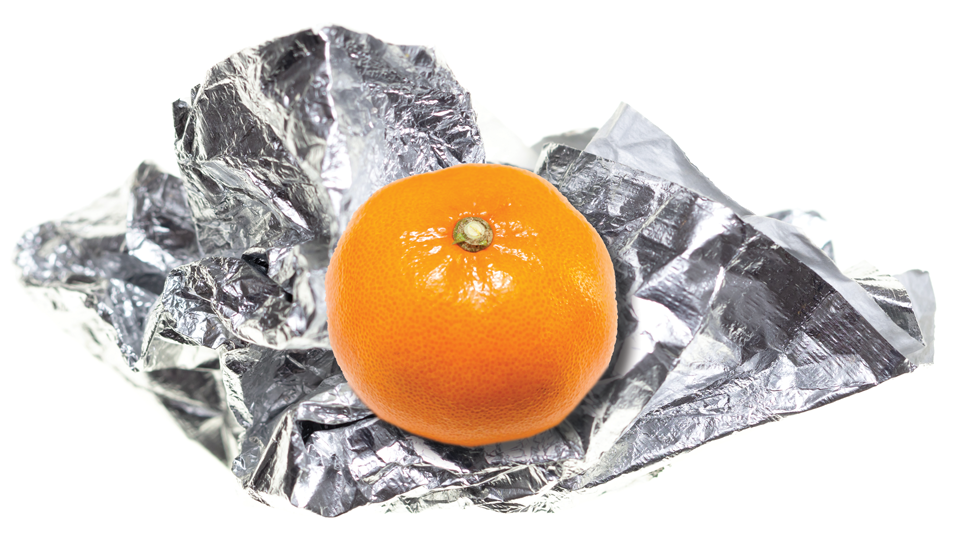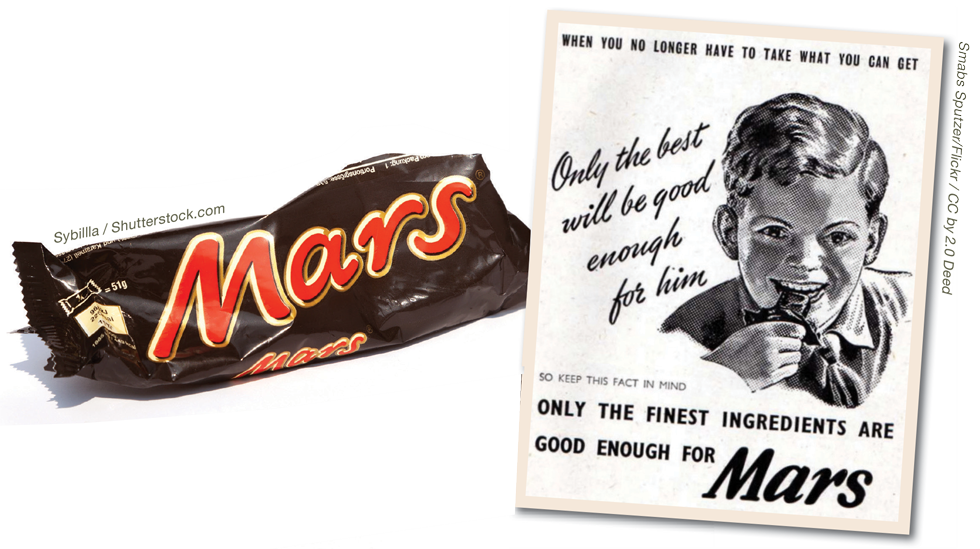Christmas Past: A Historical Christmas Stocking

Martin Pitt reminisces on Christmases past, and brings with him a sackful of facts and figures
IN THE 1950s, my brother and I would wake up early on Christmas morning and feel around in the dark to see if Santa had filled our stockings (Dad’s stockings, of course, because they were bigger). The contents were supposed to keep us occupied until Mum and Dad said we could come down to see the presents under the tree.
Usually, they would contain the following:
- something wrapped in silver foil – a satsuma if you were good (a treat in the middle of winter), a piece of coal if not (we never got coal)
- money to spend – sixpence (2.5p) at the beginning, rising to half a crown (12.5p) in later years
- something to eat – a few sweets or a Mars Bar
- something to read – a comic or a little book
- a puzzle – for example a plastic maze which you had to tilt to work a ball bearing to the middle. A harder and better one had some mercury,
- initially scattered around the labyrinth. It took ages gathering it together into a single blob to work to the centre. It would get broken releasing the mercury, so they were banned in the 1960s
- a toy, often a vehicle – my brother liked racing cars, while I preferred ones that did something, like a tipper truck or fire engine
This wave of nostalgia gave me an idea for a history of chemical engineering Christmas stocking to reflect my childhood gifts.
Something wrapped in silver foil
We called it silver, but it was very thin aluminium, and my parents called it tin foil, for the very good reason that silver foil had formerly been made of tin. In 1810, inventor Thomas Hancock (1786–1865) produced the first tin roller system to make it widely available (his other inventions will be dealt with in a later article).
Aluminium is difficult to extract from its ore, so in the 19th century it was more expensive than gold. French president and emperor, Napoleon III (1808–1873) had aluminium cutlery for his most important guests, gold for the others. In 1886, by a remarkable coincidence, two 22-year-olds, American chemist Charles Martin Hall (1863–1914) and French inventor Paul Louis-Toussaint Héroult (1863–1914) both came up with the idea of dissolving alumina (Al2O3 – melting point 2,072°C) in the mineral cryolite (Na3AlF6 – melting point 1,012°C), allowing electrolysis of alumina to take place at just under 1,000°C, greatly reducing the cost.
In 1910, Swiss industrialist Robert Victor Neher (1886–1918) patented his process for rolling thin strips of aluminium foil and in 1917, the (Swiss) Tobler company used it to wrap their iconic triangular chocolate bar. It was next used for packets of soup, then cigarettes.
The big change came in 1941 when the US declared war on Japan, which controlled 70% of the world’s tin supply. The US switched to aluminium wherever possible, and a salesman discovered foil could be used for cooking. So, after the war, aluminium cooking foil came to the UK, though still called tin foil by older generations.

Silver foil for wrapping
Silver foil had been dropped by German bombers to reflect searchlights and confuse gunners during the Second World War. It was picked up by the people below and used for Christmas decorations.
Money and the Mars bar
In 1970 as a chemical engineering technician, I earned £820 (US$1,968) a year, or £16 per week. That doesn’t sound much, but of course things were cheaper then. How can we compare? In 1988, Financial Times columnist Nico Colchester suggested that in place of gold, the little luxury of a Mars Bar (invented in 1932 in Slough) would do as a standard. He described it as “a basket of staple commodities (cocoa, vegetable fats, milk solids, sugar) packaged with great consistency in the form of an ingot”. The Mars Bar Standard (MBS) could be used to see how salaries and prices have gone up or down irrespective of inflation.

He gave as an example a graduate joining chemical company ICI. In 1940, they typically earned £275 a year. Since £1 would buy 120 bars, this is an income of MB 33,000. Someone joining the same company in 1988 might expect £5,700. However, as the price of a bar had risen, that would be MB 38,000, only a moderate increase. As a Mars Bar cost 7d (2.9p) in 1970, my salary was MB 28,000. Various authors have used it to compare prices of things at different times. The standard worked well until 2015 when the weight was reduced from 58 g (similar to the 1940 two-ounce bar) to 51 g, supposedly to aid in calorie control.
In 1986, Economist writer Pam Woodall suggested the Big Mac Index to compare the value of money in different countries. This “burgernomics” has now been going long enough to have some historical value as well.
Aluminium is difficult to extract from its ore, so in the 19th century it was more expensive than gold. French president and emperor, Napoleon III had aluminium cutlery for his most important guests, gold for the others
Grossmann’s little book
The first textbook of chemical engineering was not George Davis’s Handbook of Chemical Engineering, which was a reference for professionals and far too heavy for a stocking. A textbook is intended for the instruction of students, and the first was The Elements of Chemical Engineering in 1906, by Jacob Grossmann (d 28 Nov 1919), a founder member of the Society of Chemical Industry. It was only 17 cm x 10.8 cm, small enough for a pocket or stocking, but provided a very clear illustration of how chemical engineering is carried out in industry by comparison with chemistry bench work, which would have been familiar to all students in the first ever chemical engineering courses (carried out by his friend John Hinchley (1871–1931), the first secretary of the IChemE) from 1909.
Chapter 1 The Beaker and its Technical Equivalents covers industrial vessels, stirring, heating, and evaporation. Subsequent chapters covered: (2) distillation, (3) drying, (4) furnaces, (5) steam, (6) heat and combustion, (7) solids-liquid separation, (8) particle size reduction, (9) measuring instruments, (10) materials of construction, and (11) design.
In the last chapter he complains “the present system of teaching chemical technology is such as to render its study unnecessarily difficult”. He goes on to say: “Too many types of machinery and plant are presented to the student at once, as they occur in certain industries…he is likely to miss the essential principles which underlie both the chemical and engineering problems of manufacture.”It is supported by worked examples involving mass balance and energy usage to minimise the use of both. A substantial difference from Davis is the inclusion of costing (now considered an essential part of a chemical engineering degree). Extensive tables are given of costs of chemicals and other raw materials, materials of construction, labour, and other costs.
This little book used familiar examples to help students link to the common principles in large-scale processes, enabling teachers such as Hinchley to begin to create chemical engineers as Davis envisaged them. As chemeng 101 it was deservedly a bestseller.
You can read it online at the Internet Archive.1
Jacob Grossmann also featured in the TCE article A Wasted Life.2
The first textbook of chemical engineering was not George Davis’s 'Handbook of Chemical Engineering', which was a reference for professionals and far too heavy for a stocking...the first was 'The Elements of Chemical Engineering' in 1906

The energy maze puzzle
Chemical plants often have lots of streams which need heating and others which need cooling. The key has always been to minimise energy usage by moving the heat around.
The technology was there in the form of the trusty heat exchanger, and the mathematical tools for thermodynamics and heat transfer were well established. The only difficulty was the complex maze of typical plant arrangements and the different stream temperatures, so no one knew how to design the most thermodynamically efficient one. It was like a strategy for gathering up blobs of mercury from arbitrary positions to get to the centre (lowest energy use), with the driving force being temperature difference instead of gravitational slope.
The academic world was largely united in its opinion that the solution was simulation with ever more powerful computers and mathematics. This was something that could not be solved analytically except for trivial examples. The rising cost of energy and the oil crisis of 1973 meant that research efforts and money were redoubled, with bigger computers and more mathematics.
Then in 1978, German chemical engineering student Bodo Linnhoff (1948–) and his British PhD supervisor John R Flower (1936–2001) published a paper, Synthesis of heat exchanger networks: I. Systematic generation of energy optimal networks,3 which explained how to solve the problem by plotting all hot and cold streams as two lines on one graph. The point at which the two lines met, or crossed, was called the pinch, and showed the minimum temperature difference possible, from which heat exchanger systems could be devised.
They had difficulty getting the paper (and its second part) accepted, but pinch analysis is now recognised as revolutionary, and was called by IChemE president Rolf Prince (1928–2017) “the greatest chemical engineering discovery of the second half of the 20th century”. The practical application immediately produced energy savings of a million pounds a year on an ICI plant expansion. The vast amount of energy and thus CO2 which has been saved since using pinch analysis is something for which chemical engineers get no credit. However, Linnhoff did become a millionaire.
Professor Thring’s toy fire engine
In 1953, Australian-born Meredith Thring (1915–2006) became professor of fuel technology and chemical engineering at the University of Sheffield. In 1961 there was a new building, and he was pleased to have the royal patron of IChemE, Prince Philip (1921–2021), to open it. As someone keen on engineering and technological progress, Philip was undoubtedly aware of Thring’s reputation as an inventor and looked forward to seeing a new toy.
This was a time before microchips or even minicomputers. Nevertheless, Thring had created an autonomous mobile robot called Felix. It was designed to act as a nightwatchman in warehouses, following a pre-programmed path around the site. Its infrared eye watched out for the beginnings of a fire, and it would leave its routine to confront the danger with its on-board extinguisher.

For the demonstration, it was programmed to trundle around the yard of the building while a fire was started in a drum. Everyone watched as it went about its duty, spotted the fire, and headed towards it. The extinguisher was raised when it suddenly spotted a hotter fire – the sun, just over the shoulder of the royal guest! The prince was hurriedly moved, just in time for Felix to valiantly try to extinguish the sun.
Thring’s talents extended across many disciplines, and he was a futurist: promoting sustainability, the circular economy, and intermediate technology for developing countries, long before others. He built a stair-climbing robot and one for clearing tables as part of an effort to help disabled people.
He also played a big part in combustion and rocket research, setting up facilities which were later used by a successor departmental head, Jim Swithenbank (1931–), for work with NASA.
Which all leads quite neatly from Christmas to the New Year which is often celebrated with rockets of all shapes, sizes, and colours. To bring in 2024, I will be celebrating rocket engineers in my next article.
References
1. The Elements of Chemical Engineering: Jacob Grossmann: https://archive.org/details/cu31924030694008
2. https://www.thechemicalengineer.com/features/a-wasted-life/
3. https://aiche.onlinelibrary.wiley.com/doi/10.1002/aic.690240411
Martin Pitt CEng FIChemE is a regular contributor. Read other articles in his history series: https://www.thechemicalengineer.com/tags/chemicalengineering-history
Recent Editions
Catch up on the latest news, views and jobs from The Chemical Engineer. Below are the four latest issues. View a wider selection of the archive from within the Magazine section of this site.




